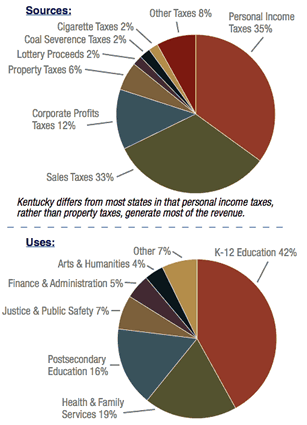Public Life Advocate
- 401 Frederica Street, B-203
- Owensboro, Kentucky 42301
- (270) 685-2652 | FAX (270) 685-6074
The State Budget
The state legislature has convened, and once again the battle lines are drawn between those who have pledged not to raise taxes and who want to shrink government, and those who claim that we are under-funded and unprepared to meet increasing needs in education, health care and other vital services.
With a modest surplus projected, should legislators stay the course and postpone significant funding of key areas? Should they cut spending on existing programs and capital projects, or rely on savings from efficiencies?
If revenue needs to be raised – state agencies have proposed a total of $2 billion in spending increases – what are the fairest and most responsible options?
Budget Basics
During the 2006 Kentucky General Assembly, legislators will consider a two-year (biennium) budget for fiscal years 2007 and 2008.
The state budget consists of two primary components: the General Fund and the Road Fund. This brief focuses on the General Fund budget, which most directly affects ongoing programs and projects funded by state government.
General Fund
|
Analysts predict that the General Fund will end the 2006 fiscal year (on June 30) with a $300 million surplus, perhaps $350 million. These forecasts change regularly.
In addition, a $124 million surplus was also carried forward from the 2005 fiscal year.
This is a considerable financial improvement over recent years. Some attribute this to an upswing in the national economy; others point to various initiatives of Gov. Ernie Fletcher.
Notwithstanding the relatively calm fiscal waters ahead, analysts warn Kentucky leaders of the roaring, rocky rapids looming around the bend.
A Balanced Budget?
The Kentucky Constitution requires a balanced budget, but legislators have managed to operate state government with an estimated $200 million “structural deficit” – that is, taking in about $200 million less than is spent and borrowing funds from various state government reserves (savings which are designated for other purposes) in order to balance the budget.
Reserves that have been drawn from in recent years include:
- $59 million from the Kentucky Higher Education Student Loan Corporation
- $63 million from a fund dedicated to the cleanup of leaking underground petroleum storage tanks
- $70 million from Kentucky Access High Risk (health care) Pool
- State government’s Budget Reserve Trust “Rainy Day” Fund
- Fees earmarked for various state boards and commissions
Debt
The 2005 legislature adopted a budget containing the highest new debt burden ever authorized – $2.2 billion in bonds for capital projects across the state. Officials also delayed the start of 20-year bond payments to reduce short-term financial pressures. (Some analysts are concerned that this could threaten Kentucky’s bond rating, increase interest rates or limit important investments in other areas.)
Kentucky state government now carries the seventh highest per capita state and local debt in the nation, and second highest relative to state revenues.
Reserves
The Fletcher administration has dedicated the maximum allowed by law to the restoration of the Budget Reserve Trust Fund (“Rainy Day” Fund). The fund reached a high of $278 million during the Patton administration, but was depleted during the shortfalls in 2001-2003. The fund increased from $29 million in fiscal year 2005 to $119 million in fiscal year 2006.

